The Tour of Mont Blanc, a 110-mile hike through the Alps in France, Italy and Switzerland, meanders through villages and is connected by an extensive system of refuges (huts), hostels and inns. Though some carry full backpacking gear for a mountain expedition, many carry daypacks and take advantage of the many shelters.
Once the decision is made to stay in some form of lodging, the next consideration is whether to carry all of the necessary gear or hire a service to transport luggage from hut-to-hut. My husband and I hiked the trail in 2016, staying at refuges and small inns along the way. We are used to backpacking so it took some thought to decide what to do. We opted for the relative luxury of hut-to-inn, but carried all of our gear while hiking. Not having to carry a tent, stove or sleeping bag made for a much lighter pack than what we were used to.
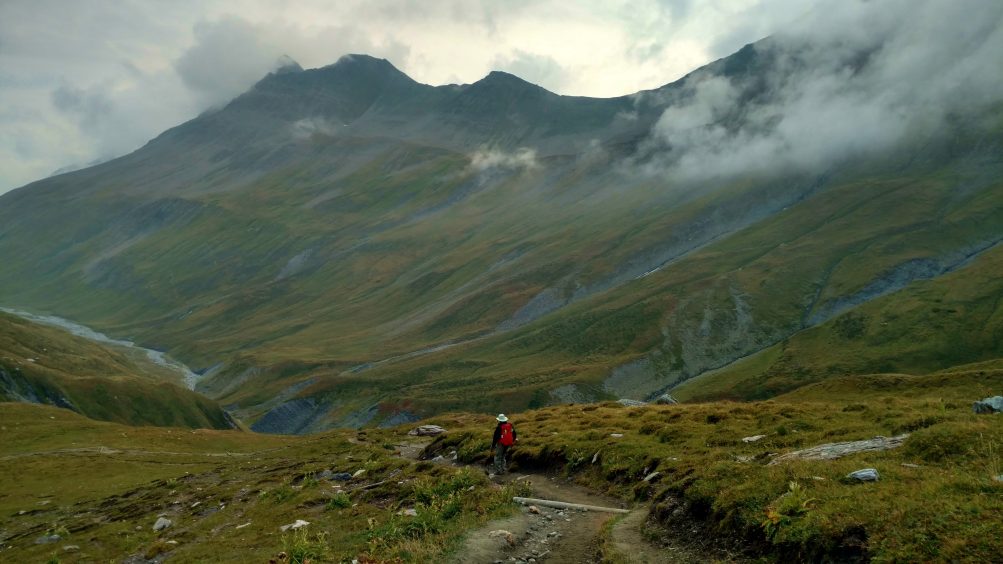
Steve hikes down the trail on the Tour of Mont Blanc
Everyone’s needs and preferences are different, but in general, the rigorous hike will be more pleasant if you don’t overpack. We saw some huge, heavy packs and heard complaints from inexperienced hikers who knew they had made a mistake by carrying rucksacks the size of refrigerators. Longtime backpackers are all too familiar with the long process of lightening their load.
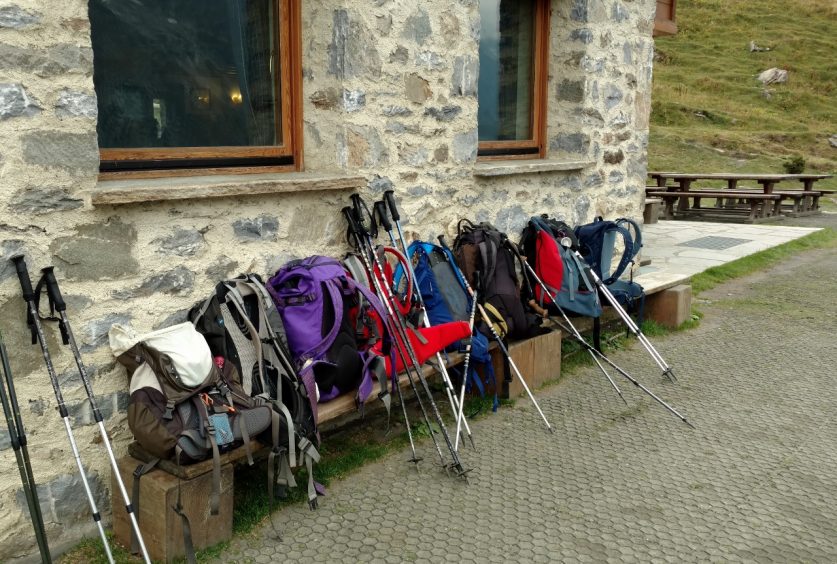
Pack sizes vary but a light pack is always appreciated.
The following are my suggestions for what to pack for a hut-to-inn hike.
- Pack
- Around 35 liters is a reasonable capacity for a daypack. It should have a sturdy hip and chest strap to stabilize the weight and enough structure to hold its shape when packed.
- Hiking clothes (no cotton, which doesn’t dry quickly and can contribute to hypothermia in wet conditions). Plan to rinse your shirt, underwear, and socks every day to prevent over-packing. Some of the refuges had drying rooms and everything dried by morning.
- Lightweight hiking pants (either zip-off or not), leggings or shorts
- Short- or long-sleeved hiking shirt
- Socks, quick-drying synthetic or merino wool, thick or thin depending on preference
- Underwear
- Boots or trail runners, depending on preference
- Waterproof boots are beneficial as rain is to be expected in the mountains. I brought non-waterproof boots and it worked out since they were able to dry out each night in inns and refuges but if you have them, bring the waterproof boots.
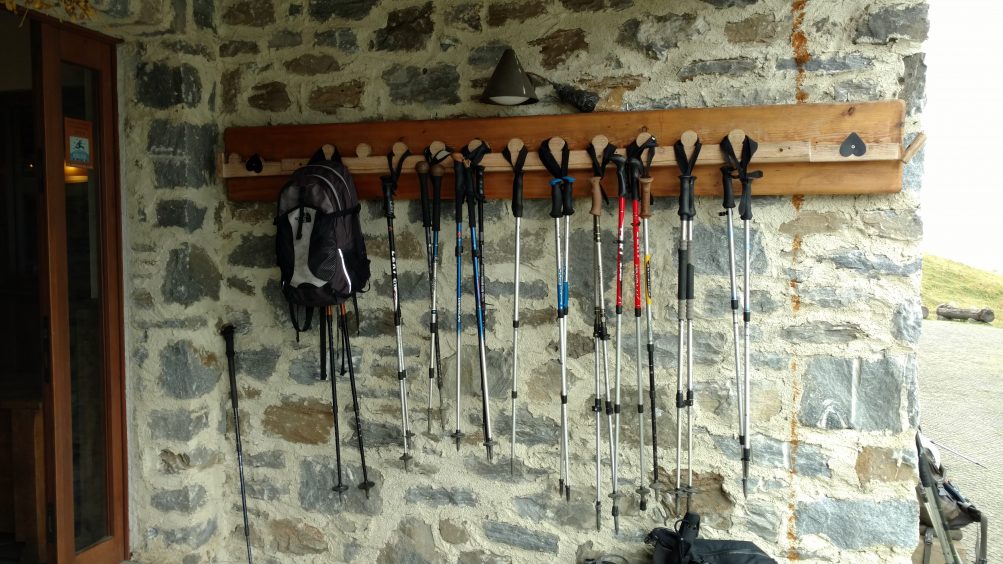
Trekking poles are a common sight in the Alps.
- Trekking poles are highly recommended, especially if you’re doing the counterclockwise Chamonix to Courmayeur segment where several stretches are very steep. More than 90% of hikers were observed used trekking poles.
- Hat
- Brimmed sun hat
- Warm hat (fleece or wool)
- Sunglasses
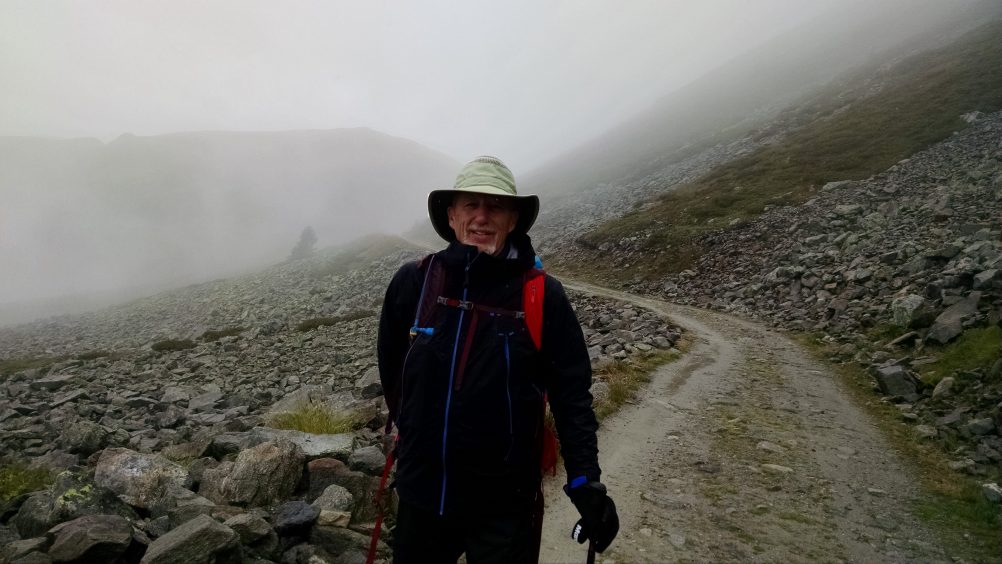
It can be chilly so bring some warm, waterproof layers.
- Rain gear
- Rain jacket or poncho (mandatory)
- Rain pants (recommended)
- Pack cover or waterproof liner (e.g. plastic bag)
- Warm jacket
- Light down or fleece jacket
- Gloves
- Warm and waterproof, e.g. glove liners and outer waterproof mitt

A pack with a hip belt and chest strap will stabilize the load.
- Comfortable evening/sleep clothes
- Lounging pants, e.g. leggings, lightweight sweat pants. Generally the inns are warm and toasty so you don’t need sweat pants or overly warm clothing.
- T-shirt.
- Dry socks, just for evening.
- I used my flip-flops a few times in the huts and for showers. The refuges and inns often require removal of your hiking boots at the door for storage in a mud room. Some have Crocs or slippers for guests to use.
- Consider what you’d be comfortable going out to dinner wearing. We usually had half-board (breakfast and dinner included). In Courmayeur we only had breakfast included so we ate out two nights in a row. The norm for dress in town was casual but not sloppy so I was glad to have semi-nice clothing to wear.
- Refuges require a sleeping bag liner (or sleep sack). We found a lightweight (4 oz/115 grams) silk liner on Amazon that worked well (Marycrafts 100% mulberry silk sleeping bag liner).
- Toiletries
- There are pharmacies in most of the villages but not near the mountain refuges. Bring anything you must have, including shampoo, toothpaste and personal medications.
- Microfiber camp towel
Download my free first-aid-kit packing list.
- Sunscreen
- Insect repellent
- Water
- Hydration bladder or water bottle, minimum one-liter capacity.
- Potable water is generally available at cafes and refuges. If you plan ahead you may not need to purify water from streams. I brought chlorine tablets and only had to use them for creek water once.
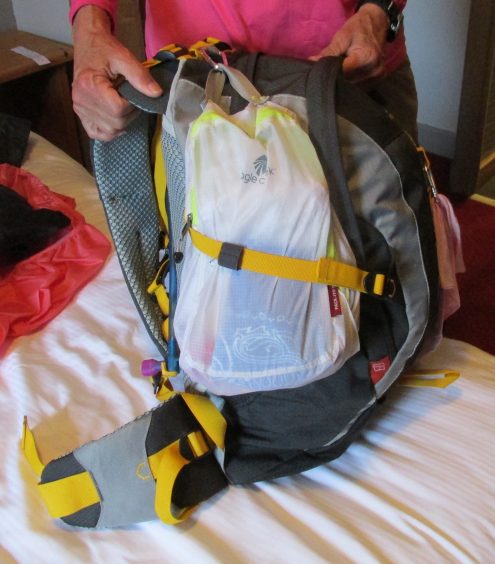
Make sure your lunch food is easily accessible.
- Food bag
- I found it useful to carry a small ditty bag that clipped to the outside of my pack to carry lunch and snacks. I packed a bandana to spread our lunch on.
- Toilet supplies
- If you carry toilet paper, bring a baggie to pack it out. You can dispose of it each night wherever you lodge. There was a disturbing amount of toilet paper strewn on the trail—please don’t contribute to the trash and follow Leave No Trace principles.
- Ladies, consider using a pee rag.
- Camera (or phone with camera)
- Entertainment
- There are no TVs and often no Wi-Fi in the refuges. The inns provided free Wi-Fi and some had TVs in the rooms. I used my phone for entertainment, including reading books on the Kindle app. I listened to audiobooks and podcasts that I had downloaded at home. I brought a small notebook and recorded a few notes each evening.
The Tour of Mont Blanc offers options for different hiking styles including guided, supported, self-guided, refuge-to-refuge and inn-to-inn. The style of hiking will dictate what you pack but this list provides an overview of what hikers should carry if they have lodging. For backpackers, see sample gear lists on my Backpacking Resources page and my series of articles, What’s in my Pack? We weren’t backpacking on this trip but the article on What’s In My Pack: Ten Little Things still applied to our hut-to-hut hike.
Other articles on the Tour of Mont Blanc by Inga Aksamit:
Tour Companies (there are many)
- Mont Blanc Treks, can assist with making lodging reservations for self-guided tours, as well as arranging guided tours. This is the only service I have personal experience with and can highly recommend it. We chose the self-guided tour and carried all of our own gear. The service they provided for us was making reservations for lodging each night and providing detailed route cards, but they offer much more.
- Mac’s Adventure, offers a range of itineraries. A friend is using this service, choosing the “Relaxed Tour du Mont Blanc,” with a couple of extra days built into the itinerary. He chose to have his luggage transported so only day-packs will be needed.
Guidebooks
Websites
Facebook Group
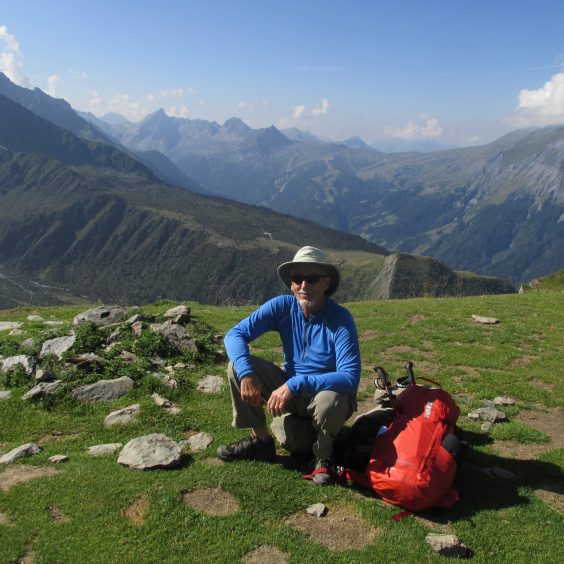
Steve takes a break with his pack at his side.
All photos by Inga Aksamit, unless otherwise credited.
 Previous Post
Previous Post

Dan DeCubellis says:
I appreciate these articles and all your work on facebook. Thank you. As to the hotels, I’m a little concerned about the distance from the trail to the hotels as I expect the hike to be fairly difficult without adding in extra elevation gain/loss. What was your experience?
Inga Aksamit 2 says:
Hi Dan,
There wasn’t much extra elevation gain or loss associated with getting to the hotels. The trail passes through towns and the hotels were sometimes a block, sometimes several blocks, but it wasn’t a lot of extra hiking. Of course, that depends on where your hotel is and with the increased popularity of the trail, I see people having to book longer distances from the trail so it can vary. Good luck with your planning.